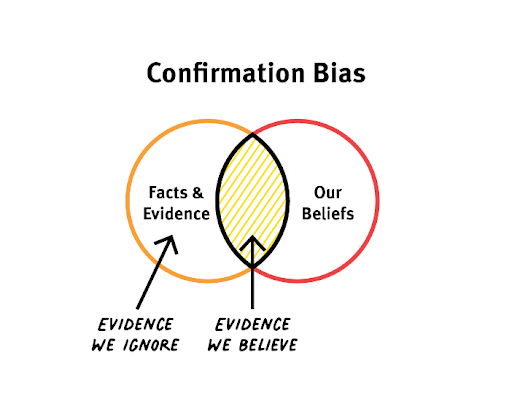Hitler, Holmes and your Homie’s love story! #BreakTheBias
On 22 June 1941, Joseph Stalin was a livid man: Nazi Germany had just launched an all-out invasion of the Soviet Union. Over the course of this operation, the Nazis sent over 3.8 million personnel across the border into Russia, the largest invasion force in the history of warfare. Hitler wasn’t about to leave any stone unturned.
And yet, by 1943, the Nazis had utterly failed in their goal to capture Russia, and had to beat a humiliating retreat. How did they manage to lose so badly?
Many of Hitler’s advisers had warned him of the potential risks of his plan, but he decided that they weren’t all that serious. Fresh from the incredibly quick military successes the Nazis had just had in Europe, Hitler let hubris get to him. Because he thought that the Russian invasion would be over in just a few months, the Nazis didn’t even plan for the winter of 1941, which was when their downfall began.
In other words, when planning for a Russian invasion, Hitler couldn’t shake off certain preconceived notions that he had, and he chose to ignore information or concerns that flew in the face of those notions.
So, after feeling challenged or forewarned, possibly with prior experiences that suggested that Hitler should not take the action he was about to, he felt more committed to his original stance. The net effect of having his position challenged was a re-entrenchment of his existing beliefs!
He had thus fallen prey to a pervasive cognitive bias all people struggle with: confirmation bias.
As Elizabeth Kolbert from The New Yorker observed, “Presented with someone else’s argument, we’re quite adept at spotting the weaknesses in their arguments. Almost invariably, the positions we’re blind about are our own.”
What is confirmation bias?
People are only prepared to see what they want to see.
From a generic perspective, Confirmation Bias is a concept through which we search for and imbibe information that aligns with our preconceived notions and opinions. As a behavior, we tend to ignore the facts that challenge our beliefs and miss out on objective information in front of us. In a nutshell, rejecting the unfamiliar, embracing the known.


Bias in everyday life: The limitations of reason
The confirmation bias is pervasive in our day-to-day lives. For example: My friend David works at a leading Indian advertising agency and happens to be left-handed. Over the years he has started believing that left-handed people are more likely to be creative and hence he (without saying so explicitly) looks for left-handed artists to collaborate with. In fact, anytime he notices a left handed person who happens to be a "dabba" in creativity, he somehow finds a way to spot (this non existent) creativity even in the way they take out coins from their pocket!


I asked him recently how is he so sure if left handed people are in fact more creative? A man of reason (and armed with the Internet), he searched on Google right in front of me: “Are left handed people more creative?” and found numerous links showing me that even Google supported his hypothesis. He got quite angry when I simply replaced the word ‘left’ with ‘right‘ and many links showing just the opposite, showed up.
I’m sure even you didn’t realize that Google throws up results knowing fully well you are more likely to click on links that tend to validate what you already think!
Is confirmation bias really true? Your answer is below!
-png.png)
-png.png)
As we navigate our lives, we normally allow ourselves to be guided by impressions and feelings, and the confidence we have in our intuitive beliefs and preferences is usually justified. But not always. We are often confident even when we are wrong, and an objective observer is more likely to detect our errors than we are — Daniel Kahneman, Thinking, Fast And Slow
Behavioral finance vis-à-vis Confirmation Bias
Behavioral finance, a subset of Behavioral economics, states that multiple psychological factors and cognitive biases impact our financial behavior and decisions. Confirmation bias is one of them.
Think about it. Don’t most investors rely on information that just best suits their opinions? Doesn’t this lead to poor investing decisions? After all, it’s easier to believe in what you already think is correct and continue to make the same decisions thinking that the same outcomes will be reached again, despite market fluctuations or other economic events suggesting otherwise. Investors skew their investment decisions based on such already held notions, as they filter out or reject facts and theories that do not match their opinions.
Change is hard, after all. Well, at least unpleasant.
-jpg.jpeg)
-jpg.jpeg)
Bias in Investing: A cautionary tale
Have you heard of the extraordinary story of an incredible company called Theranos?
In the early 2010s, this health-tech firm made the startling claim that it had invented a revolutionary device that could automatically carry out blood tests using only a few drops of blood. Among the health conditions these tests could supposedly detect were cancer, HIV, and diabetes.
Everyone who looked into this company soon found their jaw dropping to the floor. Clearly, Theranos was going to change the world, save countless lives, and make anyone who invested in it, obscenely wealthy. Would-be investors fell over themselves to pour billions into this gold mine of a company. Its charismatic founder, Elizabeth Holmes, soon found herself with the distinction of being the world’s youngest self-made female billionaire. I had become her fan too- although I suspect it was more than just the Theranos story that led to that.
Theranos’ investors eventually included the Walton family (of Walmart fame), the Cox family (of Cox Media Group), Rupert Murdoch, and US politician Betsy DeVos. Moreover, among its directors were Henry Kissinger and George Shultz (both former US Secretaries of State), William Perry (a former US Secretary of Defense), and several former US Senators. What else did a company need to have a squeaky-clean image?
If you don’t know what happened next, it will BLOW YOUR MIND.
Before long, it came to light that the whole thing was a mirage. Theranos’ devices couldn’t actually ever do what they claimed to do: it had all been a bunch of lies. The company folded over like a house of cards in a hurricane. Early investors in the company ended up losing hundreds of millions. Holmes lost her fortune, and found herself convicted of criminal fraud.
But how could something like this have happened? How could such clearly smart and experienced investors apart from the rest of us mere mortals possibly have fallen for this smoke-and-mirrors act? Shouldn’t they have known better? Wasn’t it almost obvious that Theranos’ claims were too good to be true?
Why didn’t investors care that there was no peer-reviewed research behind the company’s devices? And why didn’t they have Theranos’ claims independently verified with a team of their own choosing? Perhaps they did, and Holmes managed to mollify or hoodwink them. But what’s undeniable is that confirmation bias was also at play here, in all its deceptive glory.
They wanted their own ‘To most, it sounds like it’s too good to be true, but I’ll make millions’ story. They wanted it all (and desperately so) to be true. So whatever fiction was thrown at them, they all lapped it up.
Am I right, or am I right?
Even when looking for the best fit for mutual funds, we often look for one-sided information that confirms our opinions. In the process to do so, we discount information that opposes our beliefs.
As a general example, it is quite safe to say that an investor who holds stocks in a certain sector, pays more attention to good news in that sector and rejects or ignores the bad news. This is quite similar to what happens after you make an expensive purchase- you feel nervous and clutch at anything to justify to others why you made that expensive purchase. Seeking validation. Avoiding what is known as cognitive dissonance- the mental discomfort that results from holding two conflicting beliefs.
Let's speak numbers
In 2021, according to a survey commissioned by Schwab Asset Management in collaboration with the Investments & Wealth Institute and Cerulli Associates, BeFi Barometer 2021 reported that Confirmation bias covers 50% of all behavioral biases affecting client investment decisions. So, to speak, one out of two investors looks for information that fosters her/his already conceived perception. (Source)
.png)
.png)
Why avoid confirmation bias in investing?
It ain’t what you don’t know that gets you into trouble. It’s what you know for sure that just ain’t so. -Mark Twain.
Cognitive bias paralyses our rational thinking and comes in the way of pragmatic decisions while investing. Here’s why it can be dangerous:
- Half information is no information at all: When an investor digs into an investment fraught with bias, they may miss out on some really good avenues and take steps that do not make financial sense. Making good choices while investing needs expertise, experience or at least a rational mind. Making decisions on gut and notions can be a recipe for disaster.
- 'Bubbles’ will burst financial stability: A herd mentality prompts a speculative ‘bubble’ in the investing domain, wherein investors that dwell on confirmation bias end up investing in what everyone is investing. Such bubbles occur when the prices of certain stocks are unjustifiably high. And these two biases are often observed hand-in-hand.
What is herd mentality? Here’s our very interesting analogy on the concept. Click here.
- Less diversification, less safety: A fund manager strategically optimizes the diversification of investors’ funds as they have research-backed expertise. A victim of confirmation bias has blinkers on and ignores the potential of diversification in stocks other than those they believe will make profits.
Let’s fight confirmation bias, one step at a time!
To build a healthy & rational portfolio, it is crucial to #BreaktheBias and make decisions based on thorough research, understanding your own risk make-up and if needed, intelligent advice.
- Identify the elephant in the room
The first step towards overcoming confirmation bias is to accept that it exists- Acceptance is half the battle won. Then, try to get counter-opinions and challenge your existing viewpoints.
- Always play the devil's advocate
Challenge yourself before taking the plunge by assessing a situation with a holistic mindset and asking the right questions. Bombard a topic from all angles, no matter how weird some seem. Look for arguments that discount your original opinions. In short, train yourself to look for disconfirmation.
- Hear it from the horse's mouth
The biggest antidote to any bias is well-researched, verified but importantly, balanced data. Train yourself to trust a financial advisor or a MF Distributor who doesn’t just agree with you all the time or pushes you to answer uncomfortable questions. Trust those fund managers who don’t just show you the good side while telling you about their management styles but also openly talk about the risks involved and what could go wrong. Competent experts truly help you think objectively.
Click here to read what our horses say (our fund managers’ frameworks)- they say a lot more than just “Buy because I say so”.
- Knowledge is your best friend
There is nothing like too much gyaan (unless you’re on Twitter all the time, of course). Research and kill it. Don’t bet your assets on something that you believe in but don’t have proper reasoning for. Anything about investing is a serious business. Wealth can get built but lives can get destroyed too. So, be informed and research and gain as much information as possible about a particular stock or fund you’re interested in, before you invest.
To Conclude
“What the human being is best at doing is interpreting all new information so that their prior conclusions remain intact.” - Warren Buffett
Confirmation bias exists because we’re human and humans get emotional. When it comes to money, however, it is our responsibility to stay rational and #BreakTheBias. Which is why we made a fun little video series to make you aware of various behavioral biases that can come in the way of good investing decisions, via the life insights & observations from two hilarious comedians!
Watch & #BreakTheBias:
Before I sign off, let me tell you a long, personal, painful love story in a few lines: I was young. In college. Foolish. Greedy for love. In my first year, I met the perfect girl. It just so happened that while she was very friendly with me, she had friendzoned me on Day One itself (which I found out years later). Except, my sweet little heart only noticed when she looked at me and smiled (how was I to know that she smiled at everybody, including our college dog), or when she would wear what was my favorite color (obviously it was her appreciation for my likes), or when she would take one of my French fries anytime our gang went to Mc Donald’s (she also took bites from other boys and girls- which I was blind to of course). Not ashamed to admit I also had my own Bollywood style thoughts (“If she picks up my calls in the first 3 rings, she wants me”) and every time she didn’t do that, it was probably her Dad or Mom or someone else around who came in the way.
Reeks of confirmation bias. But then, reeks of unrequited love, too :)
Sounds familiar?
About the author
The Rational Ghost. This is one rational storyteller that provides interesting insights & stories about investing and tries to be completely unemotional about it. Lives in the shadows, doesn’t want anyone to know its real name.Disclaimer
This note is for information purposes only. In this material DSP Asset Managers Pvt Ltd (the AMC) has used information that is publicly available and is believed to be from reliable sources. While utmost care has been exercised, the author or the AMC does not warrant the completeness or accuracy of the information and disclaims all liabilities, losses and damages arising out of the use of this information. Readers, before acting on any information herein should make their own investigation & seek appropriate professional advice. Any sector(s)/ stock(s)/ issuer(s) mentioned do not constitute any recommendation and the AMC may or may not have any future position in these. All opinions/ figures/ charts/ graphs are as on date of publishing (or as at mentioned date) and are subject to change without notice. Any logos used may be trademarks™ or registered® trademarks of their respective holders, our usage does not imply any affiliation with or endorsement by them.
Past performance may or may not be sustained in the future and should not be used as a basis for comparison with other investments.
Mutual fund investments are subject to market risks, read all scheme related documents carefully.
.png)






Leave a comment